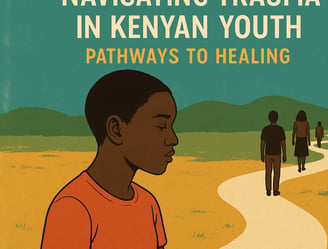Navigating Trauma in Kenyan Youth: Pathways to Healing
Across Kenya, many young people carry the invisible weight of trauma—from personal loss and community violence to the upheavals of rapid urbanization. Without early support, these wounds can hinder emotional growth, academic performance, and overall well‑being. Here’s how we can recognize, respond to, and help heal trauma in our children.
6/3/20251 min read


1. Understanding Trauma’s Footprint
Trauma is more than a single event; it’s the lasting emotional imprint after experiences like bereavement, domestic conflict, road accidents, or school violence. Affected teens may struggle with flashbacks, sleep disturbances, irritability, or sudden withdrawal.
2. Barriers to Care
Limited Awareness: Many parents and teachers mistake trauma symptoms for “bad behavior” or laziness.
Resource Gaps: Few schools offer trauma‑informed counseling, and community services are scarce outside major cities.
Stigma & Silence: Cultural norms often discourage open discussion of painful experiences, leaving students to cope alone.
3. School‑Based Strategies for Trauma Support
Safe Spaces: Establish quiet rooms or “calm corners” where students can decompress.
Peer Support Circles: Guided group sessions help youth share experiences and learn healthy coping from their peers.
Trauma‑Informed Training: Equip teachers to recognize trauma signs and respond with empathy rather than punishment.
4. The Role of Technology
Digital platforms can deliver early screening and ongoing check‑ins:
Online Assessments: Brief, confidential questionnaires flag students who may need one‑on‑one care.
Psychoeducational Modules: Interactive videos teach grounding techniques and self‑regulation exercises.
Virtual Counseling: Where in‑person services are unavailable, tele‑sessions with trained therapists ensure no child is left without support.
5. Building a Community of Healing
Parental Workshops: Educate families on trauma’s impact and simple at‑home coping activities.
Community Partnerships: Collaborate with local NGOs and faith‑based groups to extend support networks.
Policy Advocacy: Push for trauma‑informed approaches in teacher training and county health plans.
A Call to Action
By weaving trauma awareness into our schools, leveraging technology for early detection, and fostering community partnerships, Kenya can transform silent suffering into shared resilience. Let’s commit to healing—so our youth carry strength, not scars, into their futures.
Share your experiences: Have you seen trauma impact students in your community? Join the conversation below and help us build a network of care.
Student well-being
Transforming student well-being through innovative solutions.
Contact us
BeFiti ©2025. All rights reserved.
